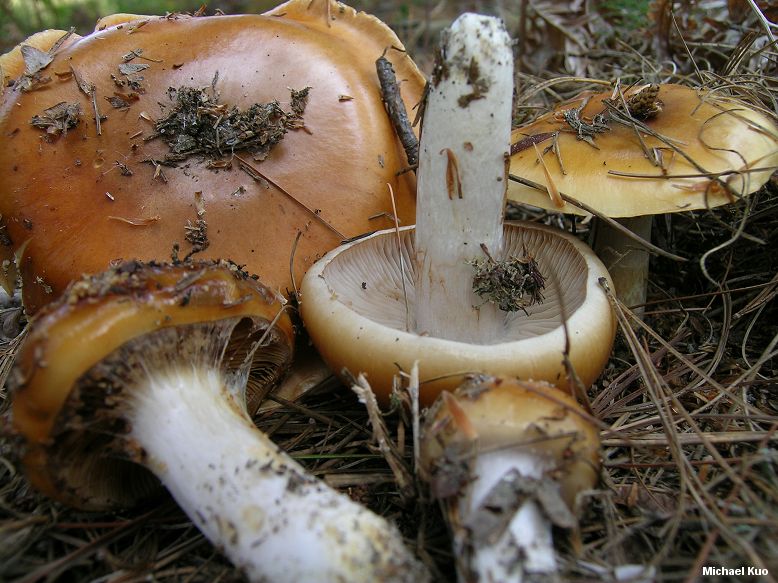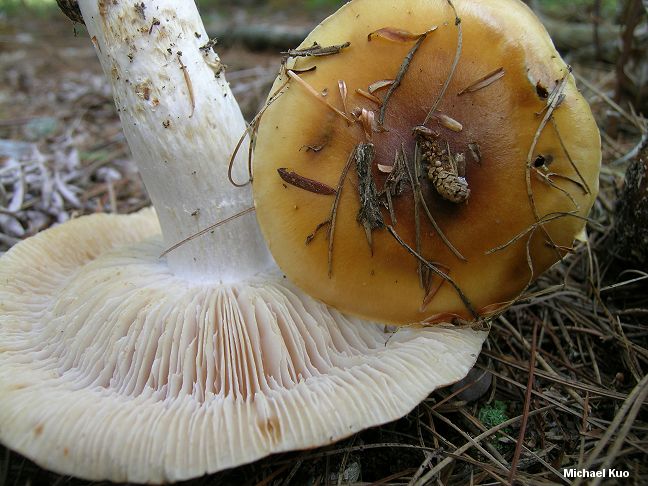Cortinarius mucosus
Heath Schleimfuß ( Cortinarius mucosus )
The Heide- Schleimfuß ( Cortinarius mucosus ) is a species of fungus in the family veil Ling relatives ( Cortinariaceae ). The yellowish to reddish brown and slimy fruit bodies are edible.
Features
Macroscopic characteristics
The fruiting bodies are covered with the remains of a slimy total envelope ( universal veil ). In young fruit bodies also a hair veil-like cover part ( Cortina ) between brim and handle exists. The thick-fleshed hat measures 4-10 cm in diameter. It is curved to spread shaped and sometimes pressed with a long incurved margin. The surface is smooth, very slimy, shiny and with yellowish or orange to reddish-brown tones colored with a darker center. The slats are narrow and are bulged grown on a stick. You are in young mushrooms ocher and discolored by the later -maturing spore powder, cinnamon or rust. The stem is 5-15 cm long, cylindrical or tapered in shape to the top and sometimes on the thickened base. Its surface is smooth or slightly scaled under the Cortina, covered slimy, white and has a brown belt zone, but no ring. The meat ( Trama ) is whitish or brownish in stem and does not have a particular taste or a particular smell.
Microscopic characteristics
The spores measure 12 to 17.5 × 5.5-7.5 micrometers, are oblong lemon-shaped, have a rough or warty surface ( ornament ) and are rust colored brown. They grow four people to the spores stands ( basidia ). At the cutting blades no sterile elements ( cheilocystidia ) occur. The cross walls ( septa ) of the fungal threads ( hyphae ) wear buckles.
Artabgrenzung
He is regarded as easily distinguishable. A toxic Verwechlungsmöglichkeit, the Bright Yellow clubfoot ( Cortinarius splendens) dar. Similar is the bitterest Schleimfuß ( Cortinarius vibratilis ), which can already individually spoil a meal. Also, the honey - Schleimfuß ( Cortinarius stillatitus ) comes for confusion in question.
Ecology and phenology
The Heide- Schleimfuß grows in acidic, sandy soil in mycorrhizal symbiosis with birch or pine trees. The fruiting bodies appear from August to October.
Dissemination
It is common in Europe and is only occasionally.
Importance
The Heide- Schleimfuß is edible and is used as an edible mushroom, but can also accumulate mercury.
Systematics and Taxonomy
It is in the section Myxacium in the subgenus of mucus feet ( Myxacium ) sorted the kind of veil Linge ( Cortinarius ). The official first description comes from a work published in 1792 by Jean Baptiste François Bulliard, where he described it as Agaricus mucosus. The Style epithet is a Latin male adjective that means " slimy ".








.jpg)
